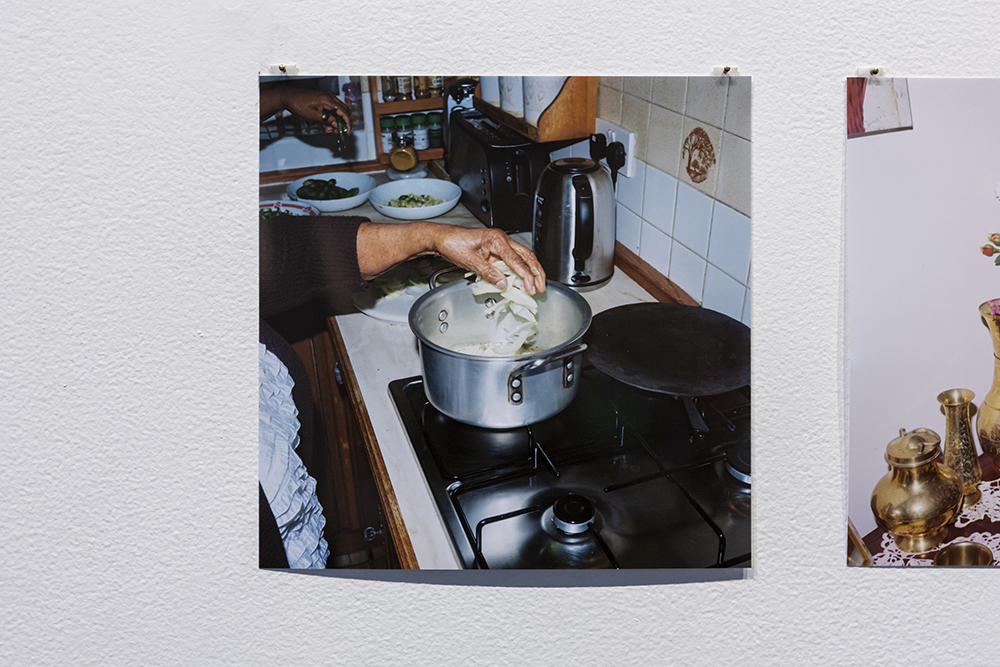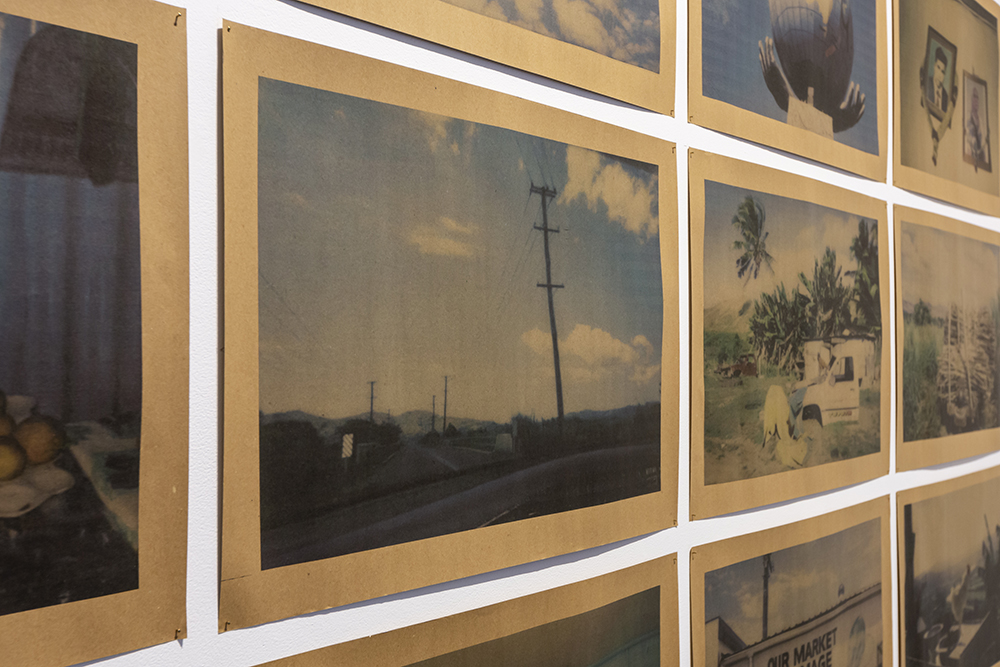Bittersweet

18 September, 2020
‘The ancestors curl and dry to scrolls of parchment.
They lie like texts
waiting to be written by the children’
David Dabydeen, Coolie Odyssey (1988)
How deep into these pixelated geographies can I possibly go?
I ask myself this as I bury the cursor into Google Earth’s digital dirt, until the screen is an assemblage of greys, greens, and browns. I remember back in high school, whenever curious friends would ask about my ‘background’, I would rely on the visual aid of Google Earth to scroll across the Pacific. I would tell them stories of family visits to Fiji, sharing what felt like an elevator pitch about my mother’s migration from Fiji to Australia, and her grandfather’s migration as an indentured labourer from India to Fiji.
Curated by Western Sydney artist and emerging curator Shivanjani Lal, Bittersweet, now on view at Casula Powerhouse, presents nine artworks by iTaukei and Indo-Fijian contemporary artists: Manisha Anjali, Mohini Chandra, Quishile Charan, Yasbelle Kerkow, Shivanjani Lal, C. A Moses, Dulcie Stewart, Luisa Tora & Sangeeta Singh and Emele Ugavule. Taken together, these works ask us to reflect on a broader conversation surrounding identity, memory, and the experience of living in diaspora. Individually, they present an urgent need to preserve, investigate, and memorialise personal connections to Fiji through various mediums (such as sound, video, photography, textiles, and fish scales tattooed with ink).
Manisha Anjali’s ‘Flower Incantation’ (2020) washes over me when I first enter the exhibition. Steady vocal vibrations fill the room. Multiple speakers are disseminating the sound and it resonates across the space. I’m spellbound by the deep, rhythmic, chanting sounds that drum and echo, that reverberate between the walls and through my body. Anjali describes ‘Flower Incantation’ as an instructive prayer for cross-generational healing, an aural realm that evokes ancestors and plantation spirits in order to welcome descendants and visitors into the space. As a rhythmic song, the work is a homage to the preservation of oral histories through vernacular folk songs. Through this storytelling, the supposed silence and subalternity of those hidden behind Eurocentric history are given their own agency. The offering of sound in ‘Flower Incantation’ resists the markers of silence and erasure. Voices of the past are found in the generations who continue to remember.

installation view, Bittersweet (2020)
Image credit: Chantel Bann, courtesy of Casula Powerhouse Arts Centre
Bittersweet is an intimate exhibition and the works on view are situated almost like whispers, inhabiting the walls and lurking in the pockets of the room. ‘Flower Incantation’, for example, fades into a kind of transcendent murmuring. This arrangement allows the works to interact with one another, which then creates a form of talanoa: a dialogue for shared and collective story-telling and inclusive knowledge-production.
Mohini Chandra’s three-screen video work ‘Kikau Street’ (2016), from her ongoing project ‘Paradise Lost’, beckons to me from the end of the room. Palm trees sway against the blue sky. One of the screens displays a shot taken through a plane window, overlooking the horizon. The aircraft’s industrial wing slices the sky from the sea; the passenger floats in the liminal space between land destinations. I think about the terminology of travel, ‘to depart from’ and ‘arrive to’—what does it mean ‘to go’ and ‘to come back’ when both destinations have been known as home?
I watch lace curtains moving with the breeze, imagining the tropical humidity. A mirror is held up to the sky, reflecting the sunlight, a makeshift tool to signal attention. I watch the waves of the ocean roll in and out from the shore. I shift between the kinds of geographies that are made tangible through digital representations, and the intangible space where my own childhood memories are harboured.
Curling into these memories at the same time as viewing Chandra’s work, I see scenes of sugar cane landscapes. I see my mother stopping by the roadside to collect sugar canes for us. The taste of their sweet husks. I see the coconut trees, the flowers, the frogs, the rain. The island of Fiji feels vast in the visualisations of my memory. Far more than the small patch of green amidst the sea of blue that Google Earth has to offer.
I then start to follow C. A Moses’ photographic series, ‘Bittersweet’ (2020), across the room, catching short glimpses into a family archive. As a medium for document-making, these photographs capture what we are trying to hold on to when we recall memories of home and family. I stop at an image of a hand suspended, frozen in time. Chopped onions fall from that hand into a pot. I imagine its contents. Aromas of fresh garlic and cumin, the sounds of sizzling oil and popping mustard seeds. In the background, another hand mimics this gesture, mirroring its suspension, holding slithers of green vegetables or green chilli. I can’t quite make out exactly what it is this hand is holding. I search deeper into the photograph, deeper into the realm of the captured memory. I imagine the people these hands belong to. I think about family and how generational knowledge is site-specific to the home. The significance the space of the kitchen holds: families coming together, the preparation of meals to share, children learning to cook by watching and mimicking approximations of ingredient measurements through pinched fingertips and handfuls.

C. A Moses, Bittersweet (2020)
Image credit: Chantel Bann, courtesy of Casula Powerhouse Arts Centre
This dwelling on family connections, the sentimentality of metaphorical explorations into memory and genealogy, is a trope that brings the works of the exhibition together. When looking at Quishile Charan’s ‘Phool’ (2019-2020), I imagine this textile artwork—made of a naturally-dyed sheet of cotton with embroidered flowers—hanging across the corner of the room, like household linen hanging on the clothesline to dry, the tropical breeze caressing the fabric. Referencing the materiality of embroidered pillowcases and duvet covers as popular hand-made gifts for loved ones, Charan translates their symbolism into emblems of memory and familial connection. The fabric is treated with tenderness: washed with water, flowers and leaves, and adorned with hand-threaded purple, yellow and red flowers. This sheet of tenderness is suspended in the space, an offer of love and an enactment of care. It is a symbolic act that preserves the familial craft practices learned within the home.
Yet, beneath these metaphorical explorations of family, home and belonging, there is something else haunting the exhibition space—the embedded knowledge of a history that can be traced through generations. Painted across the wall is Dulcie Stewart’s ‘The Colonial Wholesale’ (2020). This imagined label references the sugar packages distributed from Fiji to Australia, with the bottom-right text reading: ‘specially packed from cheap labour at the cost of generations of Girmityas and their descendants.’ Quoting John Bates Thurston, a British colonial official and later Governor of Fiji, who described the Colonial Sugar Refining Company (CSR) as ‘the most selfish company in the Australasia’s’, Stewart brings our attention to Australia’s imperialist agenda in the Pacific—CSR’s milling of sugar on the plantations in the late nineteenth and early twentieth centuries.1 The invincibility of familial connections and the visibility of their voices disintegrate when aligned with this historical context.

Shivanjani Lal, Chhaapaa (2020)
Image credit: Chantel Bann, courtesy of Casula Powerhouse Arts Centre
From 1879 to 1917, over 60,500 Indian women and men were ‘recruited’ into the indentured labour system. This ‘recruitment’ was conducted through methods of deception and false promises of better livelihoods and wealth. Women and men were taken from their homes and villages to be transported from Calcutta to work on plantations in the British colonies across the Pacific. Crossing the kala pani (black waters) to unknown geographical locations and separated from their kin, the caste system was forgone, and the notion of belonging remoulded under colonial oppression. The choice presented at the end of the five-year girmit (‘agreement’) was to return to India (at their own cost), or continue to work on the plantations along with the granted ownership of a small piece of land.
In her poem ‘Transcendental Etude’ from The Dream of a Common Language (1978), Adrienne Rich writes: ‘no one ever told us we had to study our lives, make of our lives a study.’2 The cultural histories that could have provided a context with which to find collective identity, meaning, and a sense of belonging, were not taught in our schools. And so, our desire to locate an approximation of where ‘X’ marks the spot is driven by a yearning to understand who we are—how we exist in a place whose stories do not include us. We self-study these pasts, bringing intergenerational experiences and ancestral voices into the present so they are not diminished. Through latitudes and longitudes, we search for origins to construct a sense of identity and belonging. A yearning for the geographical genesis of our being, flowing through ancestral connections, marked in the pivotal movements of past generations.
The supposed silence of the historicised subject of the subaltern is given a voice through their descendants—their children, their children’s children and their future children. The ‘coming of age’ story serves as a method for seeking out our history, making ourselves the subject and object of study, bringing to surface bitter pasts of forced removal, indenture, trauma, and violence.
In Bittersweet, these histories are re-imagined for this contemporary moment. The exhibition draws on a mode of collective storytelling that resists perpetuating historical narratives of oppression, servitude, and trauma. Notions of memory, loss, and presence are delicately threaded with their own agency, as an embodiment of bittersweet nostalgia. Bittersweet invokes the plurality of these shared experiences and histories, with the artists echoing, mirroring, and engaging with each other in acts of solidarity, care and self-preservation.